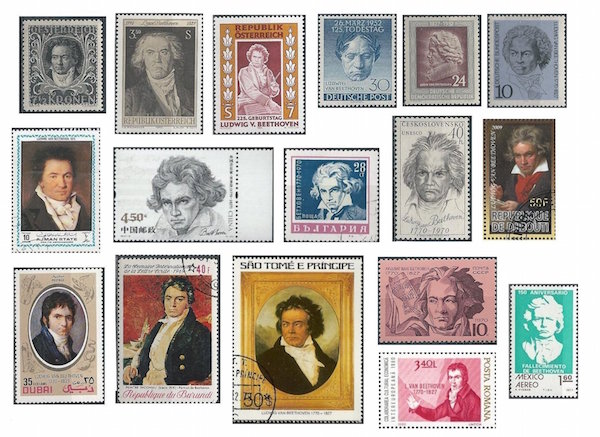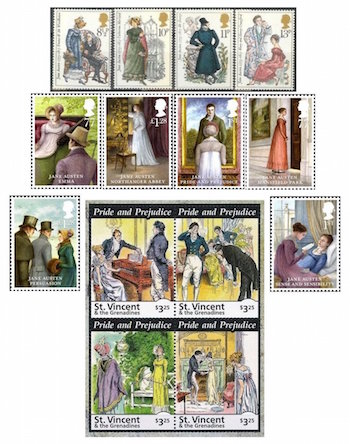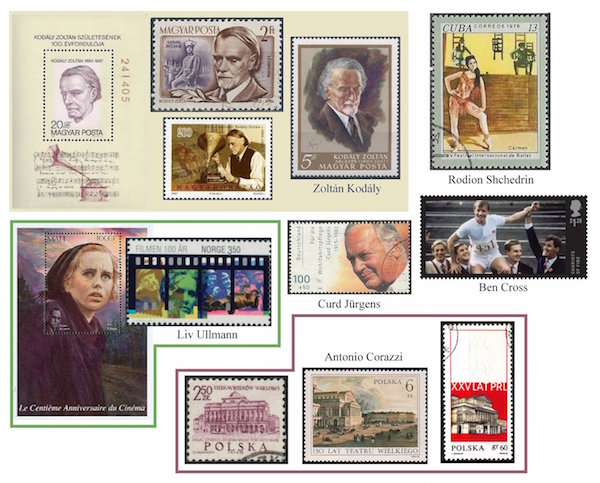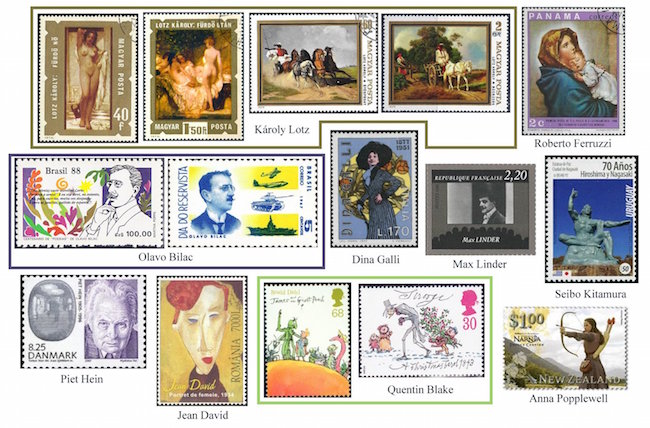The Arts on Stamps of the World — December 16
An Arts Fuse regular feature: the arts on stamps of the world.

By Doug Briscoe
Happy Beethoven’s birthday! He is the undisputed ruler of December 16, though he has stiff competition from Jane Austen and Wassily Kandinsky. Today is also the centenary of Arthur C. Clarke, who happens to share this birthday with another top-ranked science fiction writer, Philip K. Dick. We also remember Zoltán Kodály and Rodion Shchedrin among composers, and Liv Ullmann, Curt Jürgens, and Ben Cross among actors, along with many more.
I know of about seventy stamps for Ludwig van Beethoven (1770 – 26 March 1827) issued by countries all over the world (none of them, you guessed it, from the US). Only Mozart, among the great composers, has more. I thought it would be appropriate to begin with the world’s first Beethoven stamp (1922), from Austria, then two later ones from the same country. The Germans have issued about a dozen Beethovens, but oddly none more recent than 1970! I show also two from 1952 (West and East Germany), on the occasion of the 125th anniversary of the composer’s death. The rest are drawn from far and wide, including Communist China, Dubai, Burundi, Mexico, and an arresting design from the Soviet Union.
Jane Austen was born on this date in 1775. She died two hundred years ago on 18 July 1817. Quite recently two of her novels have been adapted for the operatic stage: Mansfield Park by Jonathan Dove (2011) and Pride & Prejudice by Guy Withers (2013). Great Britain issued a set of Austen stamps in 1975 depicting characters from four of the novels. A second set from 2013 gives us six stamps, one for each of her six major books. A souvenir sheet celebrating the 200th anniversary of the publication of Pride & Prejudice was issued by the island nation of Saint Vincent and the Grenadines, also in 2013. In the same year it was announced that Jane Austen’s image would appear on the new £10 note, and so it has, as of September 14th this year.

I think that unless you have a deep knowledge of modern art, you may tend to forget that Wassily Kandinsky (16 December [4 December O.S.] 1866 – 13 December 1944) was born way back in 1866 and that much of his earlier work is naturally quite representational. (Almost all of the postage stamps show his abstracts.) But then Kandinsky was already thirty when he abandoned law and economics for art. He moved toward abstraction (arriving around 1911) as Schoenberg moved toward serialism. The only stamp to honor Kandinsky without showing any of his work is this quite new one (2016) from Serbia. Next to it is a UN stamp offering Study for Composition II (1910). Then, from Sierra Leone, we have Black Accompaniment (1924) and on a Georgian stamp from 1996 an untitled (?) abstract. In the second row are Picture With A Black Arch (1912) and the coyly titled Red Oval (1920), both from Togo (one above the other); another untitled piece on a French stamp of 2003; and, from Mozambique, Merry Structure (1926) and Several Circles (1926). Finally, again from Mozambique, I thought we’d conclude with the one early representational canvas I could find on any stamp: Autumn in Bavaria from 1908.
One of the giants of science fiction was Sir Arthur C. Clarke (16 December 1917 – 19 March 2008), who also wrote extensively on science fact and was the first (in 1945) to propose a satellite communication system based on geostationary orbits. Today is the one hundredth anniversary of his birth. A few of his stories appeared in print beginning as early as 1937, but the first piece he sold remains one of his finest stories, “Rescue Party” (1946). In the meantime Clarke had served from 1941 in the RAF as a radar specialist. He married in 1953 but separated after six months and moved to Sri Lanka (then Ceylon) in 1956, citing his love of scuba diving. The likelier reason was the country’s less oppressive homosexuality laws. Clarke is buried with a Sri Lankan man Leslie Ekanayake who died before he was 30, decades before Clarke. He wrote the screenplay for 2001: A Space Odyssey (before the novelization) and received a knighthood prior to the suggested launch date of the Discovery One. Clarke is seen on a stamp from a sheet honoring SF authors from Djibouti, and 2001 gets the nod from a San Marino set that also salutes our next writer.
Coincidentally, another of the greatest sci-fi authors, Philip K(indred) Dick, was also born on a December 16 (in 1928). What a shame that he died (on March 2, 1982) before the array of motion pictures based on his stories began to appear! He did live long enough to see Ridley Scott’s Blade Runner (after the 1968 novel Do Androids Dream of Electric Sheep?) a few months before its release, and did have the satisfaction of being happy with the treatment. Eight years later the Arnold Schwarzenegger action picture Total Recall (1990, after the short story “We Can Remember It for You Wholesale” of 1966) ushered in a slew of movies (ten of them are cited on Wikipedia’s Philip K. Dick page) of variable quality, including a remake of Total Recall in 2012, and that doesn’t include the hit Amazon TV series The Man in the High Castle that began in 2015. The San Marino stamp acknowledges Blade Runner, the Italian version of the story being called Il cacciatore di androidi (The Hunter of the Androids).

The Hungarian master Zoltán Kodály (KO-dye, 16 December 1882 – 6 March 1967) is represented on four issues from his native country, including a small souvenir sheet (at left, not to scale) and a stamp that came out as recently as 2007 (with gramophone). Besides his fine compositions—the suite from the opera Háry János being the most popular—he is known for the Kodály method, a music education approach that just last year was declared a UNESCO Intangible Cultural Heritage.
Russian composer Rodion Shchedrin (b. 1932) turns 85 today. One of his best known works is the Carmen ballet (1967), based on Bizet’s opera. The Cuban stamp, one of many celebrating the Cuban ballet, shows a scene from Shchedrin’s work. There are four other ballets, six operas, three symphonies, many works in concerto form, and much vocal and piano music in Shchedrin’s canon.
Norwegian actress Liv Ullmann (born 16 December 1938), so well known for her work with Ingmar Bergman, turned to directing in 1992 and was nominated for a Palme d’Or for Faithless (2000, using a script by Bergman). Her adaptation of Miss Julie came out in 2014. She was chosen for two issues marking 100 years of cinema: a minisheet from Mali, and a stamp from Norway, which shows other Norwegian stars along with Sean Connery (can you see him?). Interesting factoids: Ullmann was born in Tokyo, lived in Toronto from age two, and then New York, before returning to her parents’ homeland of Norway; since 1985, she has been married to a real estate developer from Boston.
Curd Jürgens (13 December 1915 – 18 June 1982), usually billed in English-speaking films as Curt Jurgens, was a German-Austrian stage and film actor. His voice can be heard in the spoken rôle of Pasha Selim in Colin Davis’s superb recording of Mozart’s Abduction from the Seraglio.

English actor Ben Cross (born 16 December 1947) came to fame in the 1981 sleeper Chariots of Fire. The still from the movie that was chosen for the stamp centers on fellow actor Ian Charleson, but Cross is seen at far right. He came from a working class London family. One of his early jobs was master carpenter for the Welsh National Opera. From there he went to the Alexandra Theatre in Birmingham as property master, and by then, it would seem, he was stage struck. Recently he appeared as Spock’s father Sarek in the 2009 Star Trek movie.
Now let us revert to an earlier age. Italian architect Antonio Corazzi (16 December 1792 – April 27 1877) spent much of his working life Poland. In 1818 the kingdom of Poland made an inquiry of the state of Tuscany: Can you recommend an architect? The next year, Corazzi undertook the journey and got started right away restoring a chapel and building two palaces. The second of them was Staszic Palace (1820-23, now the Society of Friends of Science). Another of his structures for Warsaw was the Grand Theater (collab. Salami Redutowymi, 1825-33). Corazzi remained in Poland for 27 years. He returned to Italy in 1847 and accepted membership in the Academy of Fine Arts, Florence. He built at least two edifices for that city as well as theaters in Alexandria, Egypt and Copenhagen. Corazzi is not personally remembered on a stamp, but his work shows up on three Polish issues: the Staszic Palace on the violet 2.50 złoty stamp and the Grand Theater on the other two. (On the red one the upper half of the stamp may appear to be blank, but it actually contains an embossed Polish eagle.)
The painter Károly Lotz (16 December 1833 – 13 October 1904), though born Karl Lotz in Bad Homburg, Germany, grew up from about the age of four in Pest and is generally thought of as Hungarian. Most of his output is in the form of murals, but the four Hungarian stamps offer canvases: Bathing Woman, After the Bath, Coach and Five, and Farewell. Another lovely piece is his Portrait of Ilona Lippich (1894). Lotz did produce some work in Vienna and elsewhere.
The Italian painter Roberto Ferruzzi (1853 – 16 February 1934) was precisely twenty years younger than Lotz. In a parallel with the older artist he was born in Dalmatia to Italian parents and—at the age of four!—moved to Venice. Ferruzzi did go back to Dalmatia for part of his education, which continued in Venice and Padua. With his best known painting, Madonnina, he won the second Venice Biennale in 1897. It is that work that is shown on the Panamanian stamp.

The Brazilian poet Olavo Bilac (16 December 1865 – 28 December 1918) has the distinction of being the first person in Brazil to have experienced an automobile accident. This was in 1897, and I guess he walked away from it. He entered medical school at 15, switched to law and then to journalism, publishing his first poem at age 18. He was a firm believer in national conscription, and for that reason his image appears alongside fighter planes and a tank and a warship on a stamp for Reservists’ Day. You won’t be surprised to learn that he wrote the lyrics of the Brazilian Flag Anthem. You may be surprised to learn that he wrote children’s poetry and translated Wilhelm Busch‘s Max and Moritz into Portuguese.
Italian actress Dina Galli (1877 – 4 March 1951), a favorite with audiences and critics alike, was known mostly for her comic roles. Her first film appearance took place in 1914, and with the advent of war she volunteered to entertain the wounded with puppet shows. She returned to film with the talkies beginning in 1933 and had a smash hit with Felicita Colombo in 1937.
Still in the world of movie making, we salute Max Linder (16 December 1883 – 1 November 1925). Although exactly six years younger than Fina Galli, he died a quarter of a century before her when he entered into a suicide pact with his young wife. Born Gabriel-Maximilien Leuvielle in the Gironde to wealthy vineyard owners, Max disappointed them by going on the stage before he was out of his teens. He acted in classic French plays (Molière, Corneille, Musset) and adopted his stage name in 1905, the year in which he first began working in short films. By 1910, with his creation of the dapper but trouble-prone playboy “Max”, he had become one of the most popular film stars in the world. He nearly died of appendicitis that very year. After a successful series of pictures from 1912 to the start of the war, Linder, turned down for service on account of his health, drove dispatches to the front. His first bouts with depression coincided with his being invalided out. He tried his luck in Hollywood to no avail, but he did make a good friend of Charlie Chaplin.
We have many artists today but only one sculptor, Seibo Kitamura (16 December 1884 – 4 March 1987) of Japan. He studied the art from 1903 and subsequently taught it. Although Kitamura received a variety of awards throughout his long life he is best known for a single work, the Peace Statue in Nagasaki Peace Park, unveiled ten years after the dropping of the atomic bomb. Ten meters tall, this piece is reproduced on an Uruguayan stamp of 2015.
Piet Hein (16 December 1905 – 17 April 1996) was primarily a scientist, mathematician, and inventor, a colleague of Niels Bohr, but he also began writing little poems he called “grooks” after the Nazis invaded his native Denmark. These subtle encouragements to resistance were published in newspapers under the noses of the occupiers. In addition to his thousands of grooks, Hein gets a mention here on AoSofW for having proposed the use of the superellipse (the form shown on the stamp) in architecture, an idea that had a strong impact on subsequent Scandinavian building. Hein also devised a number of games, including the Soma cube puzzle.
Romanian-born Israeli artist Jean David (1908–1993), remarkably, was not only born on Beethoven’s birthday but died on 26 March, the date of Beethoven’s death. He started painting at 15 and studied in Paris from 1927 to 1933. He fled Romania for Cyprus in 1942 and served with the British navy from 1944 to 1947, after which he took residence in Israel. David mostly worked as a graphic artist in posters and industrial design, but it is one of his paintings that appears on the Romanian stamp of 2004: Portrait of a Woman (1934).
The Englishman Sir Quentin Blake (born 16 December 1932) is also a sort of an artistic stepchild, that is to say, a cartoonist and illustrator. Best known for his work on books by Roald Dahl, he has also written books for children himself. We’ve already seen this James and the Giant Peach stamp on Dahl’s birthday back in September, and we’ve also seen, on the February 7 birthday of Charles Dickens, the set Sir Quentin designed for Christmas 1993 recalling “A Christmas Carol”; so my apologies for repeating myself. But here’s something new: in 2015 a long lost manuscript by Beatrix Potter, The Tale of Kitty-in-Boots, was discovered, and last year the book was published with illustrations by Quentin Blake.

Speaking of coincidences (see para on Jean David above), the young English actress Anna Popplewell (born 16 December 1988) made her movie debut in a small role in Mansfield Park (1999)! Popplewell has since become better known for her recurring role as Susan Pevensie in The Chronicles of Narnia films. These have been accompanied by New Zealand stamps, as the films have largely been shot in that country.
Certainly there should be a stamp for George Santayana (1863 – September 26, 1952) and for two knights: Sir Noël Coward (1899 – 26 March 1973) and Sir V. S. Pritchett (1900 – 20 March 1997), all of whom were born on December 16th.
A graduate of the University of Massachusetts with a B.A. in English, Doug Briscoe worked in Boston classical music radio, at WCRB, WGBH, and WBUR, for about 25 years, beginning in 1977. He has the curious distinction of having succeeded Robert J. Lurtsema twice, first as host of WGBH’s weekday morning classical music program in 1993, then as host of the weekend program when Robert J.’s health failed in 2000. Doug also wrote liner notes for several of the late Gunther Schuller’s GM Recordings releases as well as program notes for the Boston Classical Orchestra. For the past few years he’s been posting a Facebook “blog” of classical music on stamps of the world, which has now been expanded to encompass all the arts for The Arts Fuse.
